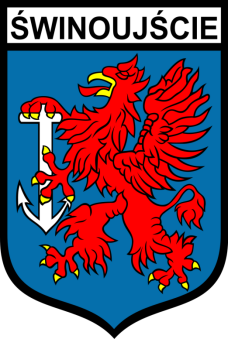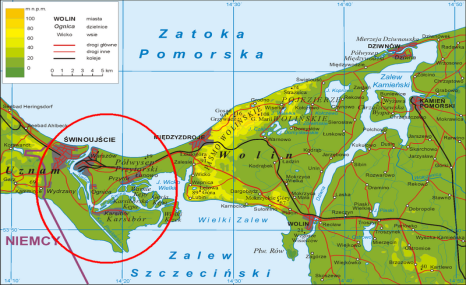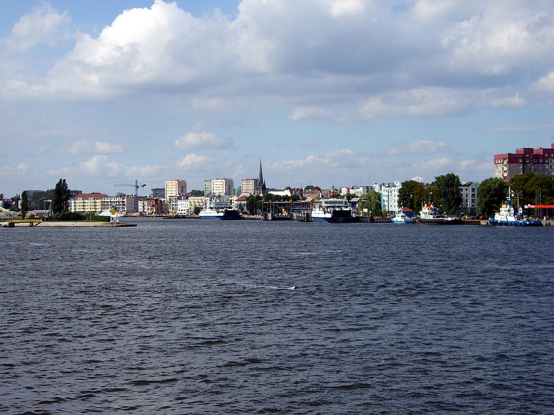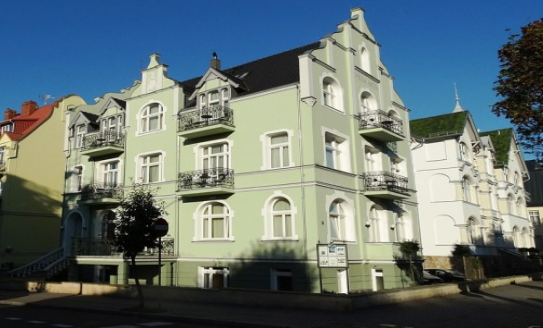Świnoujście-West Pomerania 作者: 来源: 发布时间:2021-10-27
Ⅰ. Population and Area
Area
• Total 197.23 km2 (76.15 sq mi)
Population (2012)
• Total 41,516
• Density 210/km2 (550/sq mi)
Website http://www.swinoujscie.pl/

Ⅱ.Natural Geography (environment and resources)
-The city occupies the eastern three-kilometer-wide strip of land on the island of Usedom, which became Polish territory in 1945, and the western tip of the island of Wollin. The city center is bordered in the east by the Swine , which separates the islands of Usedom and Wollin. On the east bank is the district Warszów (German Easter port and Ostswine ).

Location of Świnoujście
-Transport
-Motor vehicles and ferries
-There is a free ferry connection between the two halves of the city every 20 minutes via the Swine, which is available for all pedestrians and cyclists, but only for motor vehicles (under 3.5 t with the license plate "ZSW") of the residents (exceptions are vehicles with a special permit and 3–4 nights per week in which everyone is allowed to drive). The second, free ferry connection for heavy goods traffic as well as for foreign and foreign vehicles is located near Kaseburg. This ferry usually runs every 30 minutes.
-With the two feeders to the ferries Świnoujście-Stadt Droga krajowa 3 and Kaseburg Droga krajowa 93 , which reunite at Haferhorst to DK 3 , the connection goes over the island of Wollin in the direction of Misdroy , where the Droga wojewódzka 102 in the direction of Kolberg from the DK 3 branches off, and further south-east via Wolin (city) to Szczecin, around 100 kilometers away . The plan is to connect Świnoujście via the S 6 with the eastern Baltic region.
-For the coastal areas of northern Germany, the connection via Swinoujscie in the direction of former Pomerania and Gdansk and East Prussia with the Kaseburg ferry is the shortest route.
-A road border crossing only for coaches and cyclists was opened in April 2007 along the federal road 110 in the south of the city on Torfgraben - near the Golm - in the direction of Garz / Zirchow. On December 21, 2007, as part of Poland's accession to the Schengen Agreement, the border with the German part of the island of Usedom became the “ green border ”. Controls at all border crossings to Germany have been suspended. Since then, both border crossings to Garz and Ahlbeck have been approved for general road traffic (with the exception of trucks over 3.5 t).
-Tunnel
-The contract for the tunnel construction under the Swine or the canal was signed with the consortium leader Porr on September 17, 2018. The tunnel is intended to shorten the travel time between Usedom and Wolin and to eliminate the risk that the Swine cannot be crossed by ferry during floods, ice and storms . Alternatively, due to the difficult soil conditions ( alluvial and moorland ), a bridge was also under discussion, for which there were preliminary considerations even before 1945.
-Railway
-The railway line runs parallel to DK 3 from Ostswine (Warszów) with an arc via Misdroy, Wollin (city) and Goleniów to Stettin.
-Until June 2008, the Züssow - Wolgast Hafen - Zinnowitz - Heringsdorf - Ahlbeck line of the Usedomer Bäderbahn (UBB) was extended from the previous Ahlbeck border station to the newly built Świnoujście Centrum station , which has been in regular service since September 20, 2008.
-The reactivation of the railway line across the southwest of Usedom and the Karnin lift bridge, which was completely destroyed during the war, except for the lifting frame, is planned in order to significantly shorten the travel time by rail from Berlin and Stettin and to enable Świnoujście to be supplied with freight trains. A completely new building would be required there, the profitability of which has so far been questionable.
-Ships
-From April to October there was a connection via the Stettiner Haff and the Oder with a hydrofoil to Stettin (Bosman Express), which covered the 65-kilometer route in around 75 minutes. From the Warszów district on Wollin there are ferry connections of the Unity Line to Ystad and the TT-Line to Trelleborg in Sweden .
-Pedestrians and cyclists
-Several official long -distance cycle routes run through Swinoujscie, above all the Baltic Sea Cycle Route, which leads around the Baltic Sea, and the Iron Curtain Trail , which runs over almost 10,000 kilometers through twenty European countries from Norway to the Black Sea along the former Iron Curtain runs.
-Until 2007, the border crossing to the neighboring town of Ahlbeck was only allowed to be passed by pedestrians and cyclists.
-In 2011, Europe's longest promenade from Bansin to Swinoujscie, at 12 kilometers, was opened to pedestrians and cyclists. It had previously been redesigned and modern between Ahlbeck and Swinoujscie. A border monument was erected at the border.
Ⅲ.Economy
-port
-Port areas of Swinoujscie - on the left the trade and ferry port, on the right the city and military port and marina
-The sea port of Świnoujście is one of the most important transshipment points in Poland and on the Baltic coast. Since Poland joined the EU, cruise traffic has also become increasingly important. The port is divided into four areas, the commercial port, the ferry port for the Scandinavian ferries, the city port for excursion and technical ships and the military port. These port areas are an important pillar of the Swinoujscie economy. In addition, there is the marina belonging to the city harbor.
-The Bremer Burmester shipyard maintained from 1941 to 1945 in Swinoujscie specifically for war production two branch shipyards marina and shipyard Burmester Räumbootswerft and Ernst Burmester Shipyard KG for the war Trawler -Bau. Among other things, today's sailing cargo ship Tres Hombres was built there in 1943 as a war fishing cutter. tourism
-Świnoujście is one of the most popular holiday destinations in Poland with its beaches and various sights. In 2013 1.4 million overnight stays were registered in Swinoujscie, almost 15 percent more than in the previous year. Day tourism from the Western Pomerania area is also an important factor.
-Gazoport
-The new gasport seen from the lighthouse - 2015
-The new pier for the gas port (2.97 km long) with a mooring platform and pumping stations
-In 2010 the Gazoport project was started on the island of Wollin approx. 1.3 km east of the old eastern pier in order to be able to import large quantities of liquefied natural gas from Qatar and Algeria. The investments amounted to 700 million euros. The project led to a legal dispute with the operator of the Nord Stream natural gas pipeline. The Polish side called for the pipeline to be sunk into the seabed off Świnoujście in order to allow natural gas tankers to access the port.
-For the mooring of the large gas tankers, a new 2970 meter long pier with a mooring platform and pumping stations was built, as well as two large storage tanks and line bridges from the ship's pier to the tanks. A large processing and distribution facility was also built.
-https://de.wikipedia.org/wiki/%C5%9Awinouj%C5%9Bcie#Wirtschaft
Ⅳ.Industrial Characteristics
-The tourism and the port industry are the main economic activities in Swinoujscie. The approximately twelve kilometer long fine sandy beach from Świnoujście to Bansin stretches, on average 40 meters wide, in the further course from Usedom a total of 42 kilometers to Peenemünde , Germany. The city is connected to the towns of Bansin, Heringsdorf and Ahlbeck in Germany via the longest beach promenade in Europe, which extends over the four seaside resorts. Due to its location, Świnoujście has exceptionally favorable conditions for the development of maritime economy and tourism. "This is where Poland begins," say its inhabitants with a smile. The sea ferry terminal in Świnoujście provides permanent connections with Sweden and Denmark for passengers, cars, trucks and railway cars. The terminal is an important link between central and southern Europe and Scandinavia.
-http://www.swinoujscie.pl/pl/contents/content/37/2
-Key projects
-1. Environmental Protection Program for 2016-2019
-http://bip.um.swinoujscie.pl/artykul/1176/20869/program-ochrony-srodowiska-na-lata-2016-2019
-2. The Municipal Revitalization Program of the Świnoujście City Commune for 2017-2027
-http://bip.um.swinoujscie.pl/artykul/1176/29995/gminny-program-rewitalizacji-gminy-miasto-swinoujscie-na-lata-2017-2027
Ⅴ.Attrations and Cityscape

City panorama

Historic seaside-resort architecture in Świnoujście
-The former town hall houses the Museum of Deep Sea Fishing. Exhibits include the history of sea fishing, sea animals, the town and its region, and old navigation equipment.
-The Angel's Fort, built from 1845–1858, is a replica of Hadrian's Mausoleum (Castel Sant'Angelo in Rome).
-Concerts and art exhibitions are held at the Western Fort. Built between 1843–1863, it has been modernized a few times in the past. From after World War II until 1962 it was a headquarters of the Red Army.
-The 18th Christ the King Church in the centre of the town was erected on the site of a Gothic temple. A wooden ship replica is in the main nave. Organ concerts are presented during the summer.
-The Świnoujście Lighthouse, built in 1857, is at 68 m the highest lighthouse in Poland and on the Baltic Sea, and it is also the highest brick lighthouse in the world.
- The Stawa Młyny is a navigation beacon built in the form of a windmill on the 19th century breakwater.
-The neo-Gothic church of the Holy Mother "Stella Maris" has stained glass windows of great artistic value. It was erected at the end of the 19th century.
-The Eastern Fort, or Gerhard's Fort, is one of three preserved forts from the 19th century. It houses the Coastal Defense Museum (Muzeum Obrony Wybrzeża), with an exhibition which presents the history of the town's forts, as well as objects found there.
-The Spa Park (Park Zdrojowy) is a historic public park in the western part of the city.
-The "well" is a preserved tower of a Protestant church damaged during World War II and demolished afterwards.
-A shelter built in 1942 has the exposition "The town yesterday and now", presenting pictures of the town's history and other exhibits.
-The district of Karsibór contains an Evangelical cemetery established in the first half of 19th century.
-The Gothic church from the 15th century contains an altar from the 15th century and a pulpit from the 17th century.
-A monument honours the memory of Royal Air Force pilots shot down by the Germans while raiding the town in April 1945, located on the Karsibór island.
-Karsiborska Kępa, an island within the city limits, contains a bird sanctuary with approximately 140 species.
Ⅵ.History and Culture
-The first human settlements, in areas that are now Świnoujście appeared five thousand years ago, as confirmed by archaeological findings. For a thousand years the estuary of the river was part of the state of the Świnoujście who were included in the emerging Polish state in the 10th century by first Polish ruler Mieszko I. In the early 12th-century the island became part of the Duchy of Pomerania, founded as a vassal duchy of Poland. In later centuries local Pomeranian princes ruled the area, and on both sides of the river, they built fortified castles, which were destroyed several times by the Danish invasions in the twelfth century in 1170 and 1173. Between 1185 and 1227 the settlement was part of a Danish fief.
-During the Thirty Years' War (1618–1648) the city became part of the Swedish Empire.
-The river Świna was formerly flanked by the fishing villages of Westswine and Ostswine. Towards the beginning of the 17th century it was made navigable for large ships. The Kingdom of Prussia gained the area in 1720 from Sweden, and included it in her Pomeranian province. Świnoujście (Swinemünde) was founded on the site of Westswine in 1748, fortified, and received town privileges from King Frederick II of Prussia in 1765. It served as the outer port of Stettin (Szczecin) and was administered within the Province of Pomerania. Swinemünde became part of the German Empire after the Kingdom of Prussia completed the unification of Germany in 1871.
-The town had broad unpaved streets and one-story houses built in the Dutch style, which gave it an almost rustic appearance, although its industries, beyond some fishing, were entirely connected with its shipping. The river mouth, which was the entrance to the harbor, and which was regarded as the best on the Prussian Baltic coast, was then protected by two curving long breakwaters, and was strongly fortified. On the island of Wolin, on the other side of the narrow Świna, a great lighthouse was erected. In 1897 the canal of the Kaiserfahrt was opened to navigation, and this waterway between the Stettin harbour and the Baltic Sea was deepened between 1900–01. From then on Stettin could be reached directly by ships, and Swinemünde's importance diminished somewhat.
-During World War II, Germany operated a forced labour subcamp of the Stalag II-D prisoner-of-war camp in the city.On 12 March 1945 during World War II, refugee-crowded Swinemünde suffered heavy destruction by the USAAF, an estimated 5,000 to 23,000 were killed, most of whom are buried on the Golm War Cemetery west of the town, on the German side of the border. The city and port were also destroyed during the Allied air raids on March 12 and April 16, 1945. On April 16, 1945, a British heavy bomber of the No. 617 Squadron RAF was shot down by the Germans, and is now commemorated with a memorial on the Karsibór island within the city limits. The unfinished German aircraft carrier Graf Zeppelin was scuttled in the harbor in an attempt to prevent its capture by the advancing Red Army (it was nevertheless refloated by the Soviets later). The German battleship Schlesien had also participated in the defence of the city, before it too was scuttled. After the German forces defending the city were evacuated, Soviet forces occupied the city on the night of 4–5 May 1945.
-After Germany's defeat in the war, the Soviet Union imposed new borders in eastern Europe at the Potsdam Conference, which made the area, including Świnoujście, a part of Poland. The entire population was expelled in accordance to the Potsdam Agreement and replaced by ethnic Poles. The Treaty of Zgorzelec signed between the People's Republic of Poland and the German Democratic Republic affirmed the new border, and the German–Polish Border Treaty of 1990 officially affirmed the existing borders after the fall of the Iron Curtain.
-In the winter of 1945, some members of the communist Polish Security Forces who had been victims of German concentration camps carried out atrocities against local Germans. An investigation in 2008 estimated that over 40 German civilians were killed. Nine men were charged with the murder and maltreatment of Germans, and in 1947, after one escaped and one hanged himself, seven of them stood trial. The harshest sentence given in that trial was a mere 4 years' imprisonment, for theft. In another trial, the town's chief of police, Jan Zientara, was sentenced to eight years, for organizing robberies of German civilians.
-In 1948, the reconstruction and reconstruction of the port of Świnoujście from martial to commercial and fishing began. The construction of a large fish farm began, a huge swimming pool and industrial buildings were built, and 3 years later the Fisheries Base was commissioned. Within three years, a large fish factory was established, managed by the independent Przedsiębiorstwo Usług Rybackie Odra in Świnoujście.
-It was not until November 27, 1950, that the GDR government agreed to transfer to Poland the water intake for the city of Świnoujście, located at Lake Wolgastsee and demarcating the border there again. In June 1951, an area of 76.5 ha was incorporated into Poland together with a water treatment station, creating a characteristic promontory protruding into the German area (the so-called Worek, (53 54 49.11 N 14 11′11.18 E). In return, Germany was granted a similar area between the water intake and the Pomeranian Bay.
-The spa part of the city was occupied by the Soviet Armed Forces until 1957, and until the turn of the 1980s and 1990s, there was a base of Soviet warships with facilities in Świnoujście. Until 1972, the city belonged to the Wolin poviat. In 1959, the "Uzdrowisko Świnoujście" State Enterprise was established. Currently Uzdrowisko Świnoujście S.A. belongs to the largest and most modern in Poland, and its greatest asset is still bromide-iodide-sodium brine discovered a hundred years ago.
-In the 1960s and 1970s, a seaport was created, which together with Szczecin created a complex of ports Szczecin-Świnoujście. In 1964, ferry shipping to Scandinavia was resumed.
-In 2015 the Świnoujście LNG terminal was opened, named after the late Polish President Lech Kaczyński, during whose presidency its construction was initiated.
Ⅶ.Other Information
-Swinoujscie inGerman, is a city in northwestPoland. Its area extends to the eastern part of the island ofUsedom(Uznam)and the islands ofWollin(Wolin)andKaseburg(Karsibór)on theSzczecin Lagoonand the southern coast of theBaltic Sea. It is the outer harbor of the metropolis ofSzczecin. Świnoujście forms its own urban district in theWest Pomeranian Voivodeship.
-Swinoujscie was the third largest German Baltic resort until the Second World War , and since October 6, 1945, the place has belonged to Poland.
Ⅷ.Contact Information
-Government
- Mayor Janusz Żmurkiewicz
-tel. (91) 321-27-80,
-fax. (91) 321-59-95
-E-mail: sekretariatprezydenta@um.swinoujscie.pl
